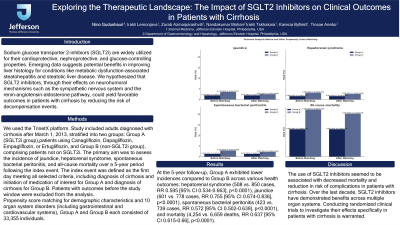Monday Poster Session
Category: Liver
P2897 - Exploring the Therapeutic Landscape: The Impact of SGLT2 Inhibitors on Clinical Outcomes in Patients With Cirrhosis
Monday, October 28, 2024
10:30 AM - 4:00 PM ET
Location: Exhibit Hall E

Has Audio

Nino Gudushauri, MD
Jefferson Einstein Hospital
Philadelphia, PA
Presenting Author(s)
Nino Gudushauri, MD1, Irakli Lemonjava, MD1, Zurab Azmaiparashvili, MD, MSc1, Nandakumar Mohan, DO2, Irakli Tskhakaia, MD1, Karecia Byfield, MBBS3, Tinsae Anebo, MD3
1Jefferson Einstein Hospital, Philadelphia, PA; 2Einstein Healthcare Network, Philadelphia, PA; 3Albert Einstein Medical Center, Philadelphia, PA
Introduction: Sodium glucose transporter 2-inhibiors (SGLT2i) are widely utilized for their cardioprotective, nephroprotective, and glucose-controlling properties. Emerging data suggests potential benefits in improving liver histology for conditions like metabolic dysfunction-associated steatohepatitis and steatotic liver disease. We hypothesized that SGLT2 inhibitors, through their effects on neurohumoral mechanisms such as the sympathetic nervous system and the renin-angiotensin-aldosterone pathway, could yield favorable outcomes in patients with cirrhosis by reducing the risk of decompensation events.
Methods: We used the TrinetX platform for cohort identification and statistical analysis. Our study included adults diagnosed with cirrhosis after March 1, 2013, stratified into two groups: Group A (SGLT2i group), comprising patients using Canagliflozin, Dapagliflozin, Empagliflozin, or Ertugliflozin, and Group B (non-SGLT2i group), comprising patients not using these medications. The primary aim was to assess the incidence of jaundice, hepatorenal syndrome, spontaneous bacterial peritonitis, and all-cause mortality over a 5-year period following the index event. The index event was defined as the first day meeting all selected criteria, including diagnosis of cirrhosis and initiation of medication of interest for Group A and diagnosis of cirrhosis for Group B. Patients with outcomes before the study window were excluded from the analysis.
After propensity score matching for demographic characteristics and 10 organ system disorders (including gastrointestinal and cardiovascular systems), Group A and Group B each consisted of 33,355 individuals.
Results: At the 5-year follow-up, Group A exhibited lower incidences compared to Group B across various health outcomes: hepatorenal syndrome (508 vs. 850 cases, RR 0.595 [95% CI 0.534-0.663], p< 0.0001), jaundice (601 vs. 778 cases, RR 0.755 [95% CI 0.674-0.836], p< 0.0001), spontaneous bacterial peritonitis (423 vs. 739 cases, RR 0.572 [95% CI 0.502-0.639], p< 0.0001), and mortality (4,254 vs. 6,659 deaths, RR 0.637 [95% CI 0.615-0.66], p< 0.0001).
Discussion: The use of SGLT2 inhibitors seemed to be associated with decreased mortality and reduction in risk of complications in patients with cirrhosis. Over the last decade, SGLT2 inhibitors have demonstrated benefits across multiple organ systems. Conducting randomized clinical trials to investigate their effects specifically in patients with cirrhosis is warranted.
Note: The table for this abstract can be viewed in the ePoster Gallery section of the ACG 2024 ePoster Site or in The American Journal of Gastroenterology's abstract supplement issue, both of which will be available starting October 27, 2024.
Disclosures:
Nino Gudushauri, MD1, Irakli Lemonjava, MD1, Zurab Azmaiparashvili, MD, MSc1, Nandakumar Mohan, DO2, Irakli Tskhakaia, MD1, Karecia Byfield, MBBS3, Tinsae Anebo, MD3. P2897 - Exploring the Therapeutic Landscape: The Impact of SGLT2 Inhibitors on Clinical Outcomes in Patients With Cirrhosis, ACG 2024 Annual Scientific Meeting Abstracts. Philadelphia, PA: American College of Gastroenterology.
1Jefferson Einstein Hospital, Philadelphia, PA; 2Einstein Healthcare Network, Philadelphia, PA; 3Albert Einstein Medical Center, Philadelphia, PA
Introduction: Sodium glucose transporter 2-inhibiors (SGLT2i) are widely utilized for their cardioprotective, nephroprotective, and glucose-controlling properties. Emerging data suggests potential benefits in improving liver histology for conditions like metabolic dysfunction-associated steatohepatitis and steatotic liver disease. We hypothesized that SGLT2 inhibitors, through their effects on neurohumoral mechanisms such as the sympathetic nervous system and the renin-angiotensin-aldosterone pathway, could yield favorable outcomes in patients with cirrhosis by reducing the risk of decompensation events.
Methods: We used the TrinetX platform for cohort identification and statistical analysis. Our study included adults diagnosed with cirrhosis after March 1, 2013, stratified into two groups: Group A (SGLT2i group), comprising patients using Canagliflozin, Dapagliflozin, Empagliflozin, or Ertugliflozin, and Group B (non-SGLT2i group), comprising patients not using these medications. The primary aim was to assess the incidence of jaundice, hepatorenal syndrome, spontaneous bacterial peritonitis, and all-cause mortality over a 5-year period following the index event. The index event was defined as the first day meeting all selected criteria, including diagnosis of cirrhosis and initiation of medication of interest for Group A and diagnosis of cirrhosis for Group B. Patients with outcomes before the study window were excluded from the analysis.
After propensity score matching for demographic characteristics and 10 organ system disorders (including gastrointestinal and cardiovascular systems), Group A and Group B each consisted of 33,355 individuals.
Results: At the 5-year follow-up, Group A exhibited lower incidences compared to Group B across various health outcomes: hepatorenal syndrome (508 vs. 850 cases, RR 0.595 [95% CI 0.534-0.663], p< 0.0001), jaundice (601 vs. 778 cases, RR 0.755 [95% CI 0.674-0.836], p< 0.0001), spontaneous bacterial peritonitis (423 vs. 739 cases, RR 0.572 [95% CI 0.502-0.639], p< 0.0001), and mortality (4,254 vs. 6,659 deaths, RR 0.637 [95% CI 0.615-0.66], p< 0.0001).
Discussion: The use of SGLT2 inhibitors seemed to be associated with decreased mortality and reduction in risk of complications in patients with cirrhosis. Over the last decade, SGLT2 inhibitors have demonstrated benefits across multiple organ systems. Conducting randomized clinical trials to investigate their effects specifically in patients with cirrhosis is warranted.
Note: The table for this abstract can be viewed in the ePoster Gallery section of the ACG 2024 ePoster Site or in The American Journal of Gastroenterology's abstract supplement issue, both of which will be available starting October 27, 2024.
Disclosures:
Nino Gudushauri indicated no relevant financial relationships.
Irakli Lemonjava indicated no relevant financial relationships.
Zurab Azmaiparashvili indicated no relevant financial relationships.
Nandakumar Mohan indicated no relevant financial relationships.
Irakli Tskhakaia indicated no relevant financial relationships.
Karecia Byfield indicated no relevant financial relationships.
Tinsae Anebo indicated no relevant financial relationships.
Nino Gudushauri, MD1, Irakli Lemonjava, MD1, Zurab Azmaiparashvili, MD, MSc1, Nandakumar Mohan, DO2, Irakli Tskhakaia, MD1, Karecia Byfield, MBBS3, Tinsae Anebo, MD3. P2897 - Exploring the Therapeutic Landscape: The Impact of SGLT2 Inhibitors on Clinical Outcomes in Patients With Cirrhosis, ACG 2024 Annual Scientific Meeting Abstracts. Philadelphia, PA: American College of Gastroenterology.
